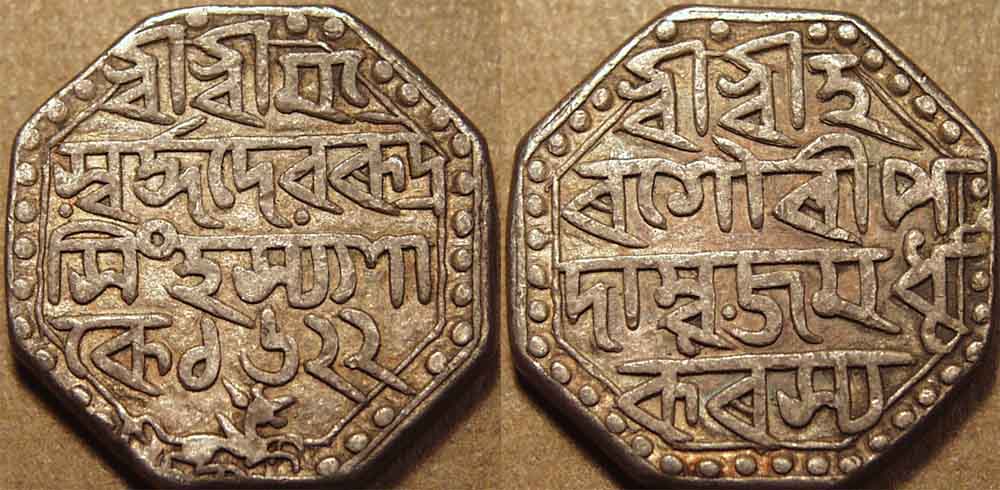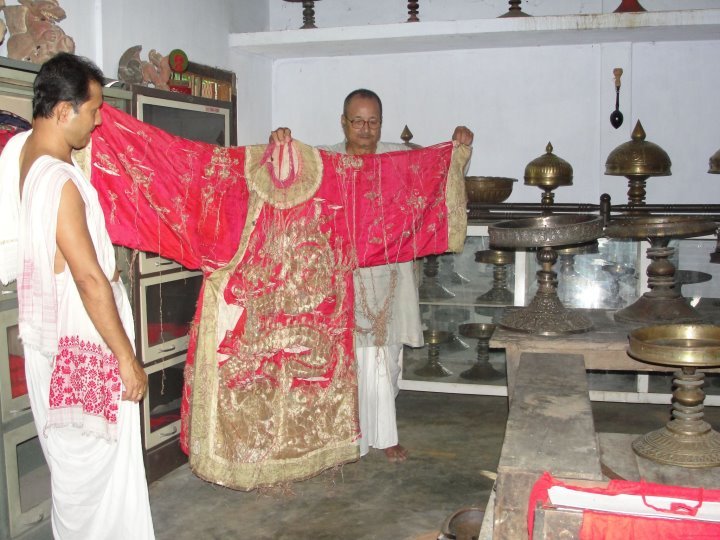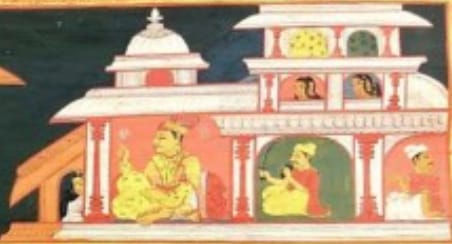|
Sukhrungphaa
Sukhrungphaa (reigned 1696–1714), or Swargadeo Rudra Singha, was a Tungkhungia ahom king and 30th king of the Ahom kingdom under whom the kingdom reached its zenith of power and glory, he is considered as the most illustrious of the Ahom kings. At Gadadhar Singha's death, his elder son Lai ascended the throne with the Ahom name of Sukharngpha and the Hindu name of Rudra Singha. An illiterate (probably dyslexic), he is best known for building a coalition of rulers in the region and raising a vast composite army against the Mughal Empire. He died on the eve of his march west from Guwahati. He had subjugated the Jayantias and the Kachari kingdoms in (1707). He built a new capital at Meteka and named it as Rangpur. Rudra Singha, following the words of his father, decided to reinstate the Vaishnava Gosain and Mahantas, he had settled the Satras in Majuli being nearer to the Ahom metropolis. He had received the initiation of Auniati Gosain, Haridev. He had invited the Beng ... [...More Info...] [...Related Items...] OR: [Wikipedia] [Google] [Baidu] |
Pramatta Singha
Sunenphaa () also, Pramatta Singha, was the king of Ahom Kingdom. He succeeded his elder brother Swargadeo Siva Singha, as the king of Ahom Kingdom. His reign of seven years was peaceful and prosperous. He constructed numerous buildings and temples. The most famous of his buildings was the Rang Ghar, which is also considered as the oldest amphitheatre in Asia. Ancestry and background Pramatta Singha was the second son of Swargadeo Rudra Singha. During the reign of his elder brother Swargadeo Siva Singha, he held the post of Charing Raja or the heir apparent to the throne. Most of the chronicles recorded that Swargadeo Rudra Singha expressed his desire at his death-bed that all his five sons Siva Singha, Pramatta Singha, Mohanmala Maladev Gohain alias Barjana Gohain, Rajeswar Singha and Lakshmi Singha successively became king, after him. Accordingly, after the death of Swargadeo Siba Singha, Chengmung Burhagohain of Pukhuriparia clan along with some other nobles decided t ... [...More Info...] [...Related Items...] OR: [Wikipedia] [Google] [Baidu] |
Jaintia Kingdom
The Jaintia Kingdom was a matrilineal kingdom in present-day Bangladesh's Sylhet Division and India's Meghalaya state. It was partitioned into three in 630 AD by Raja Guhak for his three sons, into the Jaintia Kingdom, Gour Kingdom and Laur Kingdom. It was annexed by the British East India Company in 1835. All the Khasi (Pnar) Rajahs of the Jaintiapur Kingdom are from the Syiem Sutnga clan, a Pnar clan of the Khasi tribe which claims descent from Ka Li Dohkha, a divine nymph. Etymology One theory says that the word "Jaintia" is derived the shrine of Jayanti Devi or Jainteswari, an incarnation of the Hindu goddess Durga. Another theory says that the name is derived via Pnar (the language of the rulers) from ''Sutnga'', a settlement in the modern day Jaintia Hills of Meghalaya. The Pnars (also called Jaintia by outsiders) and War, speak Mon-Khmer languages that are related to Khasi. Extent The Jaintia Kingdom extended from the east of the Shillong Plateau of prese ... [...More Info...] [...Related Items...] OR: [Wikipedia] [Google] [Baidu] |
Supatphaa
Supaatpha also, Gadadhar Singha (reign 1681–1696) established the rule of the Tungkhungia clan of the Ahom kings that ruled the Ahom kingdom till its climactic end. He was the son of Gobar Roja, a descendant of Suhungmung, and who had become the king for a mere 20 days. Previously known as Godapani, Supatphaa was able to stabilize the kingdom after the decade-long turmoil following the Ahom victory in the Battle of Saraighat. This period saw the ruthless power grab of Debera Borbarua and Laluksola Borphukan's abandonment of Guwahati and oppression via Sulikphaa ''Lora Roja''. Supatphaa retook Guwahati from the Mughals for good, and established a strong rule of 'blood and iron'. He came into conflict with the Mayamara Vaishnava ''sattra'' which belonged to the folds of Kal "songhoti"and made way for Rudra Singha, his son and succeeding king, to take the kingdom to its zenith. Supatphaa shifted the kingdom's capital to Barkola close to Garhgaon. Kinship By his lineage, ... [...More Info...] [...Related Items...] OR: [Wikipedia] [Google] [Baidu] |
Gadadhar Singha
Supaatpha also, Gadadhar Singha (reign 1681–1696) established the rule of the Tungkhungia clan of the Ahom kings that ruled the Ahom kingdom till its climactic end. He was the son of Gobar Roja, a descendant of Suhungmung, and who had become the king for a mere 20 days. Previously known as Godapani, Supatphaa was able to stabilize the kingdom after the decade-long turmoil following the Ahom victory in the Battle of Saraighat. This period saw the ruthless power grab of Debera Borbarua and Laluksola Borphukan's abandonment of Guwahati and oppression via Sulikphaa ''Lora Roja''. Supatphaa retook Guwahati from the Mughals for good, and established a strong rule of 'blood and iron'. He came into conflict with the Mayamara Vaishnava ''sattra'' which belonged to the folds of Kal "songhoti"and made way for Rudra Singha, his son and succeeding king, to take the kingdom to its zenith. Supatphaa shifted the kingdom's capital to Barkola close to Garhgaon. Kinship By his linea ... [...More Info...] [...Related Items...] OR: [Wikipedia] [Google] [Baidu] |
Jaintia Kingdom
The Jaintia Kingdom was a matrilineal kingdom in present-day Bangladesh's Sylhet Division and India's Meghalaya state. It was partitioned into three in 630 AD by Raja Guhak for his three sons, into the Jaintia Kingdom, Gour Kingdom and Laur Kingdom. It was annexed by the British East India Company in 1835. All the Khasi (Pnar) Rajahs of the Jaintiapur Kingdom are from the Syiem Sutnga clan, a Pnar clan of the Khasi tribe which claims descent from Ka Li Dohkha, a divine nymph. Etymology One theory says that the word "Jaintia" is derived the shrine of Jayanti Devi or Jainteswari, an incarnation of the Hindu goddess Durga. Another theory says that the name is derived via Pnar (the language of the rulers) from ''Sutnga'', a settlement in the modern day Jaintia Hills of Meghalaya. The Pnars (also called Jaintia by outsiders) and War, speak Mon-Khmer languages that are related to Khasi. Extent The Jaintia Kingdom extended from the east of the Shillong Plateau of prese ... [...More Info...] [...Related Items...] OR: [Wikipedia] [Google] [Baidu] |
Rajeswar Singha
Suremphaa (reign 1751–1769), or Rajeswar Singha, the fourth son of Rudra Singha, became the king of the Ahom kingdom after the death of his brother King Pramatta Singha. Rudra Singha's third son, Mohanmala Maladev Gohain, was considered ineligible for kingship as his face was pitted with smallpox marks. According to the norm established after Sulikphaa Lora Roja, an Ahom prince had to be free from any physical disability, defects or deformities to become a king. The new king was installed with the usual ceremonies. His first act was to exile his brother Mohanmala Maladev Gohain as the Raja of Namrup. During his installation as king, there was a conflict of opinion about the location of the capital between the Deodhais (Ahom priests) and the Hindu astrologers, the former recommended Taimung and the latter Rangpur. The king took the advice of the Hindu astrologers and built his palace at Rangpur, but afterwards, he built another palace at Taimung. Both the buildings wer ... [...More Info...] [...Related Items...] OR: [Wikipedia] [Google] [Baidu] |
Lakshmi Singha
Sunyeophaa also Lakshmi Singha (1769–1780), previously known as Kalsiliya Gohain, was an Ahom king. After Rajeswar Singha's death, he married Queen Kuranganayani and became the king of the Ahom kingdom. Shortly after he was installed he became a captive of the rebels of the Moamoria rebellion for a few months but soon regained his kingdom. With the help of Kuranganayani, after destroying all the Moamoria rebels including Borbaruah Ragho, Lakhmi Singha was once again crowned as king of Ahom kingdom. Accession The reign of Lakshmi Singha, who in spite of his alleged illegitimacy because of his very black complexion, succeeded Rajeswar Singha, in 1769. Keertichandra Borbarua supported the Namrup Raja, Lakshmi Singha, the youngest son of Rudra Singha who, he said, wanted that all his sons should become king in turn. The Bar Gohain and others supported the eldest son of Rajeswar Singh and raised doubts about the legitimacy of Lakshmi Singha, who was so different from Rudra Si ... [...More Info...] [...Related Items...] OR: [Wikipedia] [Google] [Baidu] |
Siva Singha
Sutanphaa also Siva Singha was a king of Assam who reigned from 1714 to 1744 A.D. He was the eldest son of Rudra Singha. Siva Singha was with his dying father at Guwahati, who then proceeded to the capital Rangpur where he ascended to the throne. He is noted is noted for his elaborate system of espionage. He had numerous temples erected and made large gifts of land to them. With his support ''Hinduism became the pre-dominant religion of the Ahoms". The king was also a patron of music and literature and music and himself composed Sanskrit songs and learnt songs. His court poets like Ananta Acharyya composed the Ananda Lahari and Kavichandra, the Kam-Kumar Haran Haran and the Dharma puran at the instance of the king and his first chief queen Phuleshwari. During his reign also came the first Europeans to trade with Assam. Reign As per the wish of Swargadeo Rudra Singha on his deathbed, he was succeeded by his eldest son Siba Singha (reigned 1714–1744). Siba Singha ascended ... [...More Info...] [...Related Items...] OR: [Wikipedia] [Google] [Baidu] |
Joymoti Konwari
Joymoti Konwari, was the wife of Tai-Ahom Prince Gadapani (later Supatphaa). She was accorded the honorific Mohiyokhi on account of her heroic endurance of torture until the end, dying at the hands of royalists under Sulikphaa ''Loraa Roja'' without disclosing her exiled husband Prince Gadapani's whereabouts, thereby enabling her husband to rise in revolt and assume kingship. Gadapani and Joymoti's son Rudra Singha had the Joysagar Tank dug at the spot where she was tortured. The first Assamese film '' Joymoti'', directed in 1935 by Jyoti Prasad Agarwala, was based on her life. Biography Joymoti was born in the middle of the 17th-century in Maduri to Laithepena Borgohain and Chandradaru. She was married to Langi Gadapani Konwar, later an Ahom king, Supatphaa, who established the Tungkhunia line of kings. During the Purge of the Princes from 1679 to 1681 under King Sulikphaa (Loraa Roja), instigated by Laluksola Borphukan, Gadapani took flight. Over the next few years, ... [...More Info...] [...Related Items...] OR: [Wikipedia] [Google] [Baidu] |
Sutanphaa
Sutanphaa also Siva Singha was a king of Assam who reigned from 1714 to 1744 A.D. He was the eldest son of Rudra Singha. Siva Singha was with his dying father at Guwahati, who then proceeded to the capital Rangpur where he ascended to the throne. He is noted is noted for his elaborate system of espionage. He had numerous temples erected and made large gifts of land to them. With his support ''Hinduism became the pre-dominant religion of the Ahoms". The king was also a patron of music and literature and music and himself composed Sanskrit songs and learnt songs. His court poets like Ananta Acharyya composed the Ananda Lahari and Kavichandra, the Kam-Kumar Haran Haran and the Dharma puran at the instance of the king and his first chief queen Phuleshwari. During his reign also came the first Europeans to trade with Assam. Reign As per the wish of Swargadeo Rudra Singha on his deathbed, he was succeeded by his eldest son Siba Singha (reigned 1714–1744). Siba Singha ascended ... [...More Info...] [...Related Items...] OR: [Wikipedia] [Google] [Baidu] |
Silver Coin Issued By Sri Sri Rudra Singha Maharaj
Silver is a chemical element with the symbol Ag (from the Latin ', derived from the Proto-Indo-European ''h₂erǵ'': "shiny" or "white") and atomic number 47. A soft, white, lustrous transition metal, it exhibits the highest electrical conductivity, thermal conductivity, and reflectivity of any metal. The metal is found in the Earth's crust in the pure, free elemental form ("native silver"), as an alloy with gold and other metals, and in minerals such as argentite and chlorargyrite. Most silver is produced as a byproduct of copper, gold, lead, and zinc refining. Silver has long been valued as a precious metal. Silver metal is used in many bullion coins, sometimes alongside gold: while it is more abundant than gold, it is much less abundant as a native metal. Its purity is typically measured on a per-mille basis; a 94%-pure alloy is described as "0.940 fine". As one of the seven metals of antiquity, silver has had an enduring role in most human cultures. Other than i ... [...More Info...] [...Related Items...] OR: [Wikipedia] [Google] [Baidu] |




._Gadadhara_Simha._1681-1696_CE.jpg)

_of_the_Ahom_Kings_25.jpg)



